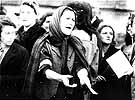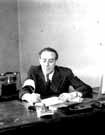
|
|
|

|

|

|

|
|
Click on an image to see a larger, more detailed picture.
|
|
|
|
|
| 1942: The "Final Solution" |

|
pg. 352 |

|
|
|
|
| |
 The plan developed at the Wannsee Conference called for a sweeping of Jews from Western to Eastern Europe. In 1942 the deportations from Occupied Western Europe began in earnest. These Jews were shipped from the Westerbork transit camp in Holland to Auschwitz. This deportation, one of the first from Holland, took place from July to October 1942.
The plan developed at the Wannsee Conference called for a sweeping of Jews from Western to Eastern Europe. In 1942 the deportations from Occupied Western Europe began in earnest. These Jews were shipped from the Westerbork transit camp in Holland to Auschwitz. This deportation, one of the first from Holland, took place from July to October 1942.
Photo: Yad Vashem / United States Holocaust Memorial Museum Photo Archive
|
 Beginning in July 1942 the Nazis undertook the deportations of Jews from the Warsaw Ghetto to the Treblinka death camp, where almost all of them were gassed as part of Operation Reinhard. These Jews were among the over 250,000 deported from Warsaw from July to September 1942. A further 13,000 would be deported to Treblinka in 1943.
Beginning in July 1942 the Nazis undertook the deportations of Jews from the Warsaw Ghetto to the Treblinka death camp, where almost all of them were gassed as part of Operation Reinhard. These Jews were among the over 250,000 deported from Warsaw from July to September 1942. A further 13,000 would be deported to Treblinka in 1943.
Photo: Leopold Pfefferberg-Page / United States Holocaust Memorial Museum Photo Archive
|
 Judenräte
Judenräte
Established by Nazi orders, the Judenrat (Jewish Council) in Lithuania's Kovno Ghetto was called the Ältestenrat (Council of Elders). Its deputy secretary, Avraham Tory, kept a diary that illustrates how this council--led by Dr. Elchanan Elkes, a prominent physician--confronted dilemmas faced by hundreds of Jewish councils (Judenräte) in Nazi-occupied Europe. Held responsible for implementing German directives, Judenrat leaders (such as the man pictured, from Bochnia, Poland) also tried to relieve community needs. The councils' conflicting responsibilities required many departments. Tory's diary entry for August 4, 1942, states how identity cards must be used by nine different offices in the Kovno Ghetto: food administration, labor, social welfare, health, police, registration, housing, economic affairs, and education. As the Nazis gradually "liquidated" Eastern Europe's ghettos during 1942 and 1943, the Judenräte led doomed communities. In autumn 1943 the Germans reclassified the Kovno Ghetto as a concentration camp. They abolished the Ältestenrat in April 1944. Kovno was home to about 37,000 Jews when the Nazis occupied the city on June 24, 1941. Only 2400 survived the war. After deportation, Dr. Elkes perished at Dachau on July 25, 1944.
Photo: Yad Vashem
|
|

|

|

|

|
 August 19, 1942: Nazis murder the children of the Rembertów (Poland) Ghetto. The town's adult Jews, more than 1000, are assembled for deportation to the Treblinka death camp. About 300 of the people are ordered eastward along the road to Wesola. Before they walk a mile, the 300 are murdered. The 700 who remain are ordered to march south, and as the group passes the town of Anin, one woman melts into a crowd of non-Jewish Polish onlookers and escapes. Forty-five others are machine-gunned at Anin, ostensibly because they attempted escape. Hours later the marchers reach the ghetto at Falenica, where Jews already have been forcibly assembled; those who are discovered in hiding are shot. Inside the ghetto, two Jews resist, using an axe to kill the first German who steps through the doors of their apartment.
August 19, 1942: Nazis murder the children of the Rembertów (Poland) Ghetto. The town's adult Jews, more than 1000, are assembled for deportation to the Treblinka death camp. About 300 of the people are ordered eastward along the road to Wesola. Before they walk a mile, the 300 are murdered. The 700 who remain are ordered to march south, and as the group passes the town of Anin, one woman melts into a crowd of non-Jewish Polish onlookers and escapes. Forty-five others are machine-gunned at Anin, ostensibly because they attempted escape. Hours later the marchers reach the ghetto at Falenica, where Jews already have been forcibly assembled; those who are discovered in hiding are shot. Inside the ghetto, two Jews resist, using an axe to kill the first German who steps through the doors of their apartment.
|
|
|
|
|
| 1942: The "Final Solution" |

|
pg. 352 |

|
|
The Holocaust Chronicle
© 2009 Publications International, Ltd.
|
|
